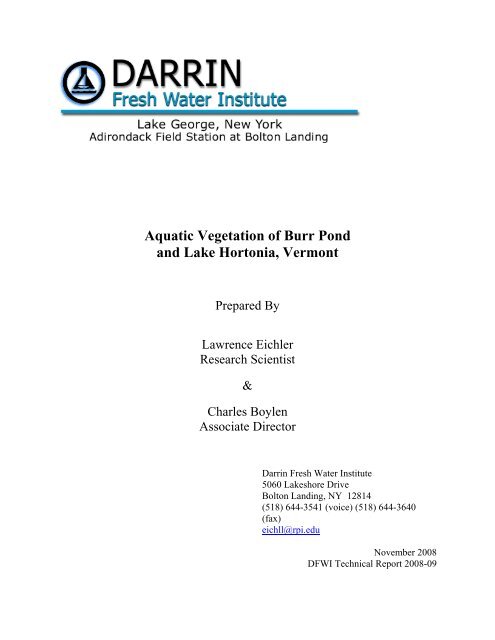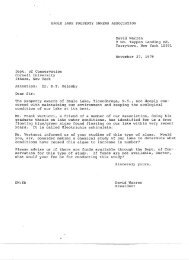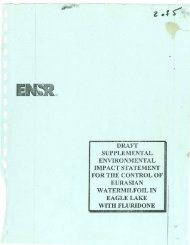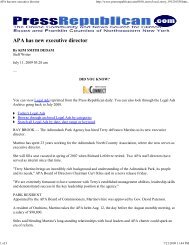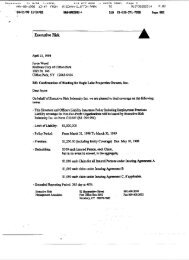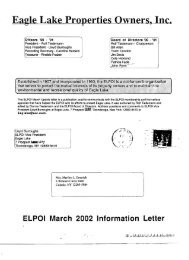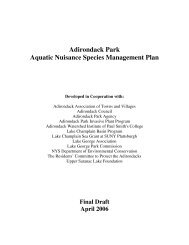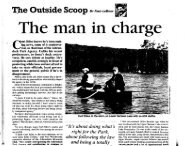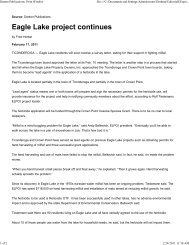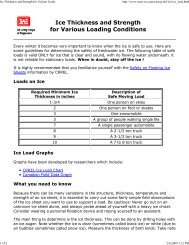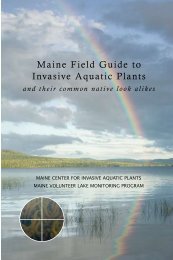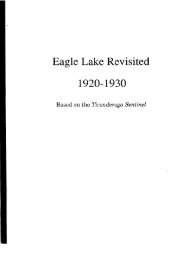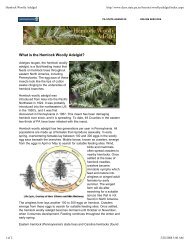Lake Hortonia 2008 - Eagle Lake Property Owner's Inc.
Lake Hortonia 2008 - Eagle Lake Property Owner's Inc.
Lake Hortonia 2008 - Eagle Lake Property Owner's Inc.
You also want an ePaper? Increase the reach of your titles
YUMPU automatically turns print PDFs into web optimized ePapers that Google loves.
Aquatic Vegetation of Burr Pond<br />
and <strong>Lake</strong> <strong>Hortonia</strong>, Vermont<br />
Prepared By<br />
Lawrence Eichler<br />
Research Scientist<br />
&<br />
Charles Boylen<br />
Associate Director<br />
Darrin Fresh Water Institute<br />
5060 <strong>Lake</strong>shore Drive<br />
Bolton Landing, NY 12814<br />
(518) 644-3541 (voice) (518) 644-3640<br />
(fax)<br />
eichll@rpi.edu<br />
November <strong>2008</strong><br />
DFWI Technical Report <strong>2008</strong>-09
TABLE OF CONTENTS<br />
Background . . . . . . . . . . . 1<br />
Methods . . . . . . . . . . . 1<br />
Survey Sites . . . . . . . . . . . 1<br />
Species List and Herbarium Specimens . . . . . . . . . . . 2<br />
Point Intercept Survey . . . . . . . . . . . 2<br />
Wetland Line Transects . . . . . . . . . . . 4<br />
Herbicide Treatment - <strong>2008</strong> . . . . . . . . . . . 5<br />
Results and Discussion<br />
Burr Pond Open-<strong>Lake</strong> Survey . . . . . . . . . . . 6<br />
Burr Pond Wetland Transect . . . . . . . . . . . 13<br />
<strong>Lake</strong> <strong>Hortonia</strong> Open-<strong>Lake</strong> Survey . . . . . . . . . . . 16<br />
<strong>Lake</strong> <strong>Hortonia</strong> Wetland Transect . . . . . . . . . . . 22<br />
Summary . . . . . . . . . . . 25<br />
References . . . . . . . . . . . 30<br />
Acknowledgements . . . . . . . . . . . 30<br />
Appendix A. Burr Pond aquatic plant distribution maps . . . . . . . . . . . A-1<br />
Appendix B. <strong>Lake</strong> <strong>Hortonia</strong> aquatic plant distribution maps . . . . . . . . . . . B-1<br />
ii
List of Tables<br />
Table 1 Species list for Burr Pond and <strong>Lake</strong> <strong>Hortonia</strong>, September <strong>2008</strong>………….. 6<br />
Table 2 Burr Pond percent frequency of occurrence data. ....…………………….. 9<br />
Page<br />
Table 3<br />
Table 4<br />
Burr Pond species richness comparison between the current survey and<br />
prior surveys ………………………………………………………………. 12<br />
Frequency of occurrence for all species and all survey years in the Burr<br />
Pond wetland transect …………………………………………………….. 14<br />
Table 5 <strong>Lake</strong> <strong>Hortonia</strong> percent frequency of occurrence data. .…………………... 18<br />
Table 6<br />
Table 7<br />
Species richness comparison between the current survey and prior surveys<br />
for <strong>Lake</strong> <strong>Hortonia</strong> ……………………………………………………….… 21<br />
Frequency of occurrence for all species and all survey years in the <strong>Lake</strong><br />
<strong>Hortonia</strong> wetland transect ………………………………………………… 22<br />
iii
List of Figures<br />
Page<br />
Figure 1 Map of Burr Pond with point intercept survey locations for <strong>2008</strong> ………. 2<br />
Figure 2 Map of <strong>Lake</strong> <strong>Hortonia</strong> with point intercept survey locations for <strong>2008</strong> ….. 3<br />
Figure 3 Depth distribution of Burr Pond sampling points in 1 meter depth classes 8<br />
Figure 4<br />
Figure 5<br />
Burr Pond frequency of occurrence summaries for sampling points of all<br />
water depths ……………………………………………………………… 10<br />
Burr Pond frequency of occurrence summaries for sampling points less<br />
than 4 meters water depth .………………………………………………. 11<br />
Figure 6 Burr Pond species richness for native species in open-lake surveys …… 13<br />
Figure 7 Burr Pond wetland transect species richness …………………………… 15<br />
Figure 8<br />
Figure 9<br />
Figure 10<br />
Depth distribution of <strong>Lake</strong> <strong>Hortonia</strong> sampling points in 1 meter depth<br />
classes ……………………………………………………………………. 16<br />
<strong>Lake</strong> <strong>Hortonia</strong> frequency of occurrence summaries for sampling points of<br />
all water depths …………………………………………………………... 19<br />
<strong>Lake</strong> <strong>Hortonia</strong> frequency of occurrence summaries for sampling points<br />
within the littoral zone (
Background.<br />
Quantitative aquatic plant surveys were undertaken for Burr Pond and <strong>Lake</strong> <strong>Hortonia</strong>, Vermont,<br />
in September of <strong>2008</strong>. Surveys of <strong>Lake</strong> <strong>Hortonia</strong> were conducted to obtain post-treatment data<br />
for spot treatments with the aquatic-labeled herbicide triclopyr (Renovate 3 TM ). Hand and<br />
suction harvesting operations were underway but incomplete on <strong>Lake</strong> <strong>Hortonia</strong> at the time of the<br />
aquatic plant survey. No treatment of Burr Pond occurred in 2007 or <strong>2008</strong>. Aquatic plant<br />
surveys were designed to be comparable to annual aquatic plant data collected by the US Army<br />
Corps of Engineers in 1999 through 2001 and by the authors in 2003 through 2007. Surveys<br />
were conducted in 2003 to prepare for and in 2004 and 2005 to evaluate a treatment program<br />
based on application of the herbicide fluridone (SONAR TM ) in 2004 to control Eurasian<br />
watermilfoil (Myriophyllum spicatum) in these two lakes.<br />
Methods<br />
Survey Sites<br />
Burr Pond. Burr Pond is located in Rutland County, Vermont in the town of Sudbury. The<br />
pond has a surface area of approximately 35 ha. Burr Pond has a single outlet, which drains to<br />
<strong>Lake</strong> <strong>Hortonia</strong>. Average water depth is reported to be 3.6 m, with a maximum depth of 6 m<br />
(Getsinger et al. 2002). Transparency via secchi disk is reported to be 4.1 m (LHPOA/BPA<br />
1999). In 1998, Burr Pond supported a diverse native plant community with 19 submersed<br />
species, 2 native rooted floating-leaf species and 1 native emergent species (LHPOA/BPA 1999).<br />
Additional data collections by the US Army Corps reported 22 submersed species, 3 floatingleaved<br />
species and 4 emergent species in 1999 through 2001 (Getsinger et al. 2002). Eurasian<br />
watermilfoil (Myriophyllum spicatum) populations were first confirmed in 1991 and reported to<br />
be the dominant aquatic plant species in the lake by the mid-1990’s (LHPOA/BPA 1999). Prior<br />
to herbicide treatment in 2000, Myriophyllum spicatum, was the most common plant species,<br />
present in >55% of survey points (Getsinger et al. 2002) and was the only exotic species<br />
reported. At the conclusion of post-treatment surveys in August 2001, frequency of occurrence<br />
of Myriophyllum spicatum had been reduced by 85%, reported in less than 10% of survey points.<br />
In a pre-treatment survey in August of 2003, Myriophyllum spicatum frequency of occurrence<br />
(49% of survey points) approached pre-treatment levels reported in 1999. Following an<br />
herbicide treatment in the Spring of 2004, Myriophyllum spicatum had been reduced by 40%,<br />
reported in less than 29% of survey points. This decline continued in 2005, with Myriophyllum<br />
spicatum reported in 22% of survey points. The entire shoreline of Burr Pond was treated with<br />
the herbicide Renovate 3 in the Spring of 2006 to further reduce Myriophyllum spicatum<br />
abundance. No treatment occurred in 2007 and limited hand harvesting was employed in <strong>2008</strong>.<br />
<strong>Lake</strong> <strong>Hortonia</strong>. <strong>Lake</strong> <strong>Hortonia</strong> is located in Rutland County, Vermont between the towns of<br />
Sudbury and Hubbardton. The pond has a surface area of approximately 194 ha. Average water<br />
depth is reported to be 5.85 m, with a maximum depth of 19 m (Getsinger et al. 2002).<br />
Transparency via secchi disk is reported to be 5.4 m (LHPOA/BPA 1999). In 1998, <strong>Lake</strong><br />
<strong>Hortonia</strong> supported a diverse native plant community with 22 submersed species, 2 rooted<br />
floating-leaf species and 4 native emergent species reported (LHPOA/BPA 1999). Additional<br />
data collections by the US Army Corps reported 24 submersed species, 2 floating-leaved species,<br />
1
1 floating species and 2 emergent species in 1999 through 2001 (Getsinger et al. 2002).<br />
Eurasian watermilfoil (Myriophyllum spicatum) populations were first confirmed in 1984 and<br />
reported to be problematic by the mid-1990’s (LHPOA/BPA 1999). Prior to herbicide treatment<br />
in 2000, Myriophyllum spicatum was the most common plant species, present in >54% of survey<br />
points (Getsinger et al. 2002). A second exotic species, Potamogeton crispus (Curly-leaf<br />
Pondweed) was also reported. At the conclusion of post-treatment surveys in August 2001,<br />
frequency of occurrence of Myriophyllum spicatum had been reduced by 85%, with this species<br />
reported in only 6% of survey points. In a pre-treatment survey in August of 2003,<br />
Myriophyllum spicatum was reported in 52% of survey points, comparable to pre-treatment<br />
frequency of occurrence reported in 1999. Following an herbicide treatment in the Spring of<br />
2004, Myriophyllum spicatum had been reduced by 33%, reported in less than 35% of survey<br />
points. Myriophyllum spicatum specimens observed in August of 2004 were generally in poor<br />
condition. An August of 2005 survey reported Myriophyllum spicatum in 2% of survey points.<br />
Spot treatments of the shoreline of <strong>Lake</strong> <strong>Hortonia</strong> with the herbicide Renovate 3 were conducted<br />
in the Spring of 2006 thru <strong>2008</strong> to further reduce Myriophyllum spicatum abundance. Hand and<br />
suction harvesting were also employed in <strong>2008</strong>.<br />
Figure 1. Map of Burr Pond with point intercept survey locations for <strong>2008</strong>.<br />
Species List and Herbarium Specimens. As the lakes were surveyed, the occurrence of each<br />
aquatic plant species observed in the lake was recorded and adequate herbarium specimens were<br />
collected. The herbarium specimens were returned to the Darrin Fresh Water Institute, where<br />
they were pressed, dried, and mounted (Hellquist 1993). A number of species which were<br />
2
collected as reference specimens for each lake were not found in line intercept or wetland<br />
transect surveys.<br />
Point Intercept Surveys. The frequency and distribution of aquatic plant species in each<br />
waterbody were evaluated using a point intercept method (Madsen 1999). At each grid point<br />
intersection, all species located at that point were recorded, as well as water depth. Water depth<br />
was determined with a weighted sounding lead and fiberglass tape measure (Keson,<br />
Warrensville, IL). Species were located by a visual inspection of the point and by deploying a<br />
rake to the bottom, and examining the plants retrieved. A total of 51 points were selected for<br />
Burr Pond (Figure 1), on a 40-m grid and 126 points for <strong>Lake</strong> <strong>Hortonia</strong> (Figure 2), on an 80-m<br />
grid. Survey points for the 2003 thru <strong>2008</strong> surveys were selected within the littoral zone of each<br />
lake, as a subset of points employed in earlier surveys (Getsinger et al. 2002). A number of<br />
deepwater points were also sampled. Locations for survey points were determined using<br />
Figure 2. Map of <strong>Lake</strong> <strong>Hortonia</strong> with point intercept survey locations for <strong>2008</strong>.<br />
MapInfo Software (MapInfo Corp., Troy, NY). A Trimble Pathfinder (Trimble Corp.,<br />
3
Sunnyvale, CA) differential global positioning system (DGPS) was used to navigate to each<br />
point for the survey observation. Point intercept plant frequencies were surveyed between<br />
September 2 and September 4, <strong>2008</strong> for both lakes. Data presented in the summaries are on both<br />
a whole-lake basis and adjusted for the littoral zone.<br />
Wetland Line Transects. To address concerns with potential impacts of herbicide treatments on<br />
wetland communities, one site at each lake was selected to correspond with surveys conducted in<br />
1999 through 2001 by the US Army Corp of Engineers (Getsinger et al. 2002). In <strong>Lake</strong><br />
<strong>Hortonia</strong>, a 200-m transect was established, with the endpoints marked by DGPS. In Burr Pond,<br />
an 80-m transect was established with physical control of location. For each transect, the line<br />
was divided into 1-m segments. Plant species occurring in a 0.1 m 2 quadrat placed at each 1-m<br />
segment were recorded (Madsen 1999). Since these transects were in dense Nymphaea-Nuphar<br />
communities, both transects were observed with the use of a canoe.<br />
Renovate Treatment – <strong>2008</strong><br />
Summary provided by Gerald Smith, Aquatic Control Technology, <strong>Inc</strong>., Cambridge, MA<br />
4
Results and Discussion<br />
Burr Pond Open-<strong>Lake</strong> Survey Results<br />
In September of <strong>2008</strong>, the aquatic plant community of Burr Pond included eighteen submersed<br />
species, two floating-leaved species, one floating species and five emergent species.<br />
Myriophyllum spicatum was the only exotic species reported for Burr Pond. Species richness<br />
was quite high, with a number of species occurring in more than 5% of survey points (Table 2).<br />
Eurasian watermilfoil increased to the most widely distributed plant (55% of survey points for<br />
Burr Pond, up from 23% of survey points in 2007, 4% in 2006, 22% in 2005, 29% in 2004 and<br />
49% in 2003). Chara sp. was the most widespread native plant (44% of survey points). A<br />
number of native species were also commonly observed. A list of species observed for Burr<br />
Pond is provided in Table 1.<br />
Table 1. Species list for Burr Pond and <strong>Lake</strong> <strong>Hortonia</strong>, September <strong>2008</strong>.<br />
Species Name<br />
Common Name<br />
Burr Pond<br />
<strong>Lake</strong> <strong>Hortonia</strong><br />
<strong>Lake</strong> Wetland <strong>Lake</strong> Wetland<br />
Brasenia schreberi Water shield X<br />
Ceratophyllum demersum L. coontail X X X X<br />
Chara sp. muskgrass, chara X X X X<br />
Eleocharis acicularis (L.) Roemer &<br />
Schultes<br />
needle spike-rush<br />
X<br />
Elodea canadensis Michx. elodea X X X X<br />
Heteranthera dubia Jacq.<br />
(Zosterella dubia)<br />
water stargrass X X X X<br />
Lemna minor L. duckweed X X<br />
Lemna trisulca L. duckweed X<br />
Megalodonta (Bidens) beckii Torr. water marigold X<br />
Myriophyllum sibiricum Kom.<br />
northern<br />
watermilfoil<br />
X<br />
X<br />
Myriophyllum spicatum L.<br />
Eurasian<br />
watermilfoil<br />
X X X<br />
Najas flexilis (Willd.) Rostk. &<br />
Schmidt.<br />
bushy pondweed X X X X<br />
Nuphar advena (Ait.) Ait. f. yellow pondlily X X X X<br />
5
Species Name<br />
Common Name<br />
Burr Pond<br />
<strong>Lake</strong> <strong>Hortonia</strong><br />
<strong>Lake</strong> Wetland <strong>Lake</strong> Wetland<br />
Nymphaea odorata Ait. white waterlily X X X X<br />
Polygonum sp. smartweed X X<br />
Pontederia cordata L. pickerelweed X X X X<br />
Potamogeton amplifolius Tuckerm. largeleaf pondweed X X<br />
Potamogeton crispus L. curlyleaf pondweed X X<br />
Potamogeton epihydrus Raf.<br />
ribbon-leaf<br />
pondweed<br />
X X X<br />
Potamogeton gramineus L.<br />
variable-leaf<br />
pondweed<br />
X<br />
X<br />
Potamogeton illinoensis Morong. Illinois pondweed X X X X<br />
Potamogeton natans L.<br />
floating-leaf<br />
pondweed<br />
X<br />
X<br />
Potamogeton (Stukenia) pectinatus L. sago pondweed X<br />
Potamogeton praelongus Wulfen<br />
white-stem<br />
pondweed<br />
X<br />
Potamogeton pusillus L. small pondweed X X X<br />
Potamogeton robbinsii Oakes Robbins’ pondweed X X<br />
Potamogeton zosteriformis Fern. flat-stem pondweed X X X<br />
Ranunculus longirostris Godron white watercrowfoot X X<br />
Scirpus sp. bulrush X X X<br />
Sparganium sp. burreed X X X<br />
Sphagnum sp. sphagnum X X<br />
Typha sp. cattail X X X X<br />
Utricularia gibba L. humped bladderwort X X X<br />
Utricularia minor L. small bladderwort X X X<br />
Utricularia vulgaris L. great bladderwort X X X X<br />
Vallisneria americana L. wild celery X X X X<br />
6
Maximum Depth of Colonization<br />
Maximum depth of rooted aquatic plant growth was similar for the two lakes, with the littoral<br />
zone extending to a maximum depth of 4 m. Depth distribution of sampling points (Figure 3)<br />
and maximum depth of colonization by aquatic plants in Burr Pond was comparable to that<br />
reported for earlier studies (Getsinger et al. 2002). A bladderwort, Utricularia gibba, was<br />
reported for a single sample in a depth of 4.5 m in 2003. This weakly rooted species may have<br />
drifted to this location and may not be able to survive. Specimens of Chara sp. were observed in<br />
a single sample from 4.7 m depth in Burr Pond in 2004 thru 2007. Numerous dead stems of<br />
Chara sp. were collected in water depths of 4.0 to 4.5 m. These results suggest the presence of<br />
an anaerobic hypolimnion in Burr Pond during summer stratification, after plant propagules have<br />
produced mature plants. Chara sp. was able to survive and grow in hypolimnetic depths during<br />
the Spring and early Summer, prior to anaerobic conditions developing. As the period of<br />
summer stratification progresses, anaerobic conditions generally move higher in the water<br />
column, resulting in the death of the Chara sp. growing there.<br />
Figure 3. Depth Distribution of Burr Pond Sampling Points in 1 meter depth classes.<br />
Percentage of Points<br />
100%<br />
90%<br />
80%<br />
70%<br />
60%<br />
50%<br />
40%<br />
30%<br />
20%<br />
10%<br />
0%<br />
Individual<br />
Cumulative<br />
1 2 3 4 5<br />
Depth (m)<br />
Species Lists<br />
Maps of the distribution of aquatic plant species and groups of species (i.e. Broad-leaf<br />
Pondweeds) for Burr Pond are included in Appendix A, Figures A1 – A10. Charophytes were<br />
the most abundant native species, present in 44% of all samples collected. Myriophyllum<br />
spicatum was the most abundant aquatic plant species occurring in Burr Pond, reported in 55%<br />
of samples collected. Common native species for Burr Pond included Utricularia gibba (32%),<br />
Vallisneria americana (28%), Potamogeton illinoensis (26%), Najas flexilis (19%), Elodea<br />
canadensis (19%), Potamogeton gramineus (9%), Nuphar advena (9%), Potamogeton pusillus<br />
(8%), and Nymphaea odorata (8%).<br />
7
Table 2. Burr Pond percent frequency of occurrence data.<br />
Results for 1999 through 2001 are derived from Getsinger et al. (2002).<br />
Species Name<br />
August Surveys<br />
1999 2000 2001 2003 2004 2005 2006 2007 <strong>2008</strong><br />
Ceratophyllum demersum 3.1% 2.6% 0.5% 3.9% 5.9% 1.9% 1.9% 1.9%<br />
Chara sp. 29.0% 36.6% 36.1% 15.7% 37.3% 44.4% 48.1% 47.2% 45.3%<br />
Eleocharis acicularis 2.0% 2.0% 1.9%<br />
Elodea canadensis 10.0% 9.4% 0.5% 5.9% 17.0% 18.9%<br />
Megalodonta beckii 0.5%<br />
Myriophyllum sibiricum 4.2%<br />
Myriophyllum spicatum 58.0% 40.8% 9.4% 49.0% 22.2% 3.7% 22.6% 54.7%<br />
Najas flexilis 11.0% 13.1% 11.8% 16.7% 16.7% 34.0% 18.9%<br />
Nuphar advena 4.7% 4.7% 6.3% 3.9% 2.0% 3.7% 3.7% 1.9% 9.4%<br />
Nymphaea odorata 8.9% 9.4% 4.2% 9.8% 2.0% 11.1% 9.3% 9.4% 7.5%<br />
Potamogeton amplifolius 1.1% 2.1% 1.6% 2.0%<br />
Potamogeton epihydrus 1.9%<br />
Potamogeton gramineus 16.2% 5.2% 4.7% 5.9% 2.0% 1.9% 13.2% 9.4%<br />
Potamogeton illinoensis 19.9% 4.7% 3.9% 2.0% 1.9% 25.9% 11.3% 26.4%<br />
Potamogeton natans 0.5% 0.5% 0.5% 2.0% 1.9% 1.9%<br />
Potamogeton nodosus 0.5%<br />
Potamogeton pusillus 1.9% 7.4% 5.7% 7.5%<br />
Potamogeton robbinsii 2.1% 6.3% 7.9% 3.9% 2.0% 5.6% 7.4% 7.5% 5.7%<br />
Potamogeton zosteriformis 6.8% 3.1% 4.7% 2.0% 13.0% 3.7% 15.1% 5.7%<br />
Ranunculus longirostris 0.5% 0.5% 1.9%<br />
Scirpus sp. 2.0% 2.0% 1.9% 1.9% 1.9%<br />
Sparganium americanum 1.6% 0.5% 2.0%<br />
Stukenia pectinatus 1.1% 0.5% 1.9%<br />
Typha sp. 2.0% 2.0% 1.9%<br />
Utricularia gibba 3.1% 5.2% 3.7% 13.7% 15.7% 27.8% 40.7% 35.8% 32.1%<br />
Utricularia minor 1.9%<br />
Utricularia vulgaris 1.1% 0.5% 3.7% 1.9%<br />
Vallisneria americana 18.0% 10.5% 8.4% 19.6% 23.5% 22.2% 29.6% 26.4% 28.3%<br />
Zosterella dubia 1.1% 6.3% 3.7% 5.9% 9.8% 13.0% 9.3% 9.4% 3.8%<br />
A total of 20 species were recorded in open lake surveys of Burr Pond in <strong>2008</strong>, similar to the 17<br />
species in 2003 and 2006 and sixteen species recorded in 2004, 2005 and 2007. These results<br />
are comparable to previous surveys (Getsinger et al. 2002) in 2001 (20 species), 2000 (16<br />
species) and 1999 (21 species). No previously unreported species for Burr Pond were<br />
encountered in <strong>2008</strong>. Species absent from the <strong>2008</strong> survey but present in prior surveys were<br />
generally either present in only a single survey year or relatively uncommon in prior surveys<br />
8
(
Seventy percent of whole lake sampling points were vegetated by at least one native plant<br />
species (Figure 4), 90% of survey points with depths less than 4 m (Figure 5) and 100% of<br />
survey points less than 2 meters depth yielded native aquatic plants. Eurasian watermilfoil was<br />
present in 52% of whole lake survey points, and 62% of survey points less than 4 m water depth,<br />
representing the littoral zone or zone of aquatic plant growth. Native species frequency on a<br />
whole lake basis has remained relatively stable over the 9 surveys at from 48 to 70% of survey<br />
points for all water depths. Eurasian watermilfoil frequency of occurrence declined rapidly<br />
between 1999 (57%) and 2001 (9%) as a result of herbicide application prior to the 2000 survey.<br />
However, by 2003 frequency of occurrence had returned to near 1999 levels (49%). In 2004,<br />
during the year of treatment, Eurasian watermilfoil frequency of occurrence once again declined<br />
(29%). This decline continued into 2005, one year post treatment, with a Eurasian watermilfoil<br />
frequency of occurrence of 22%. Spot treatments in 2006 further reduced Eurasian watermilfoil<br />
frequency of occurrence to 4%. With no treatment in 2007 and <strong>2008</strong>, Eurasian watermilfoil<br />
frequency of occurrence once again increased (23% and 52%, respectively). Total plant<br />
frequency of occurrence reflects the decline in Eurasian watermilfoil growth between 1999 and<br />
2001 following herbicide application. An increase in total plant frequency of occurrence was<br />
observed between 2001 and 2003, with this increase continuing in 2004. Total plant frequency<br />
of occurrence has remained stable from 2005 through 2007 (Figure 4), even though a additional<br />
herbicide treatments occurred in 2004 and 2006. A slight increase in overall frequency of<br />
occurrence was observed in <strong>2008</strong>.<br />
120<br />
100<br />
1999 2000 2001 2003 2004 2005 2006 2007 <strong>2008</strong><br />
Percent Occurrence<br />
80<br />
60<br />
40<br />
20<br />
0<br />
Natives Milfoil Total<br />
Figure 5. Burr Pond frequency of occurrence summaries<br />
for sampling points less than 4 meters water depth.<br />
For survey points within the littoral zone, water depth less than 4 m (Figure 5), results similar to<br />
whole lake surveys are reported. The expected relationship of greater frequency of occurrence of<br />
aquatic plants with shallower water depth is consistent with that reported by Getsinger et al.<br />
(2002), where frequency of occurrence values in the littoral zone ranged from 78 to 87% of<br />
survey points. As with whole lake survey points, Eurasian watermilfoil frequency of occurrence<br />
10
declined rapidly between 1999 (69%) and 2001 (15%) as a result of herbicide application prior<br />
to the 2000 survey. However, for the 2003 survey, frequency of occurrence of Eurasian<br />
watermilfoil in the littoral zone of Burr Pond had increased to 75%, exceeding 1999 pretreatment<br />
levels. Post-treatment results in 2004 showed a decline to 48% of survey points similar to levels<br />
reported in the year of treatment by Getsinger et al. (2002). The decline continued in 2005, one<br />
year post treatment, with Eurasian watermilfoil present in 35% of survey points. Spot treatments<br />
with Renovate in 2006 caused a further decline in Eurasian watermilfoil frequency of occurrence<br />
to 5% of survey points within the littoral zone. With no treatment in 2007 and <strong>2008</strong>, Eurasian<br />
watermilfoil frequency of occurrence increased steadily(32% and 62%, respectively).<br />
Table 3. Burr Pond species richness comparison between the current open-lake survey and<br />
surveys conducted by the US Army Corps of Engineers (Getsinger et al., 2002).<br />
Plant Water Depth Summary August Surveys<br />
Grouping Class Statistic 1999 2000 2001 2003 2004 2005 2006 2007 <strong>2008</strong><br />
Native plant Whole <strong>Lake</strong> Mean 1.43 1.05 1.02 1.22 1.14 1.65 2.17 2.35 2.28<br />
species (all depths) N 191 191 191 51 51 51 51 51 51<br />
Std. Error 0.14 0.11 0.11 0.2 0.18 0.21 0.26 0.29 0.26<br />
Points with Mean 2.51 2.04 1.83 1.84 1.81 2.32 3.06 3.29 3.08<br />
depths
zone was 1.81 species per sample, nearly identical to the 1.83 and 1.84 species per sample<br />
reported in 2001 and 2003 respectively. In 2005, native species richness in the littoral zone was<br />
2.32 species per sample, approaching the 1999 pretreatment richness of 2.51 species per sample.<br />
In 2006 thru <strong>2008</strong>, native species richness exceeded 3 species per sample point, once again<br />
largely due to Potamogeton illinoensis and Elodea canadensis. In the shallow portion of the<br />
littoral zone, depths less than 2 meters, species richness in 2004 (2.09 species per sample) was<br />
similar to the results for the entire littoral zone in 2003 (2.0 species per sample), but less than the<br />
approximately 2.6 species per survey point reported in post-treatment surveys in 2000 and 2001.<br />
From 2005 thru 2007, native species richness in the shallow portion of the littoral zone<br />
increased steadily from 2.7 to 3.44 and ultimately 3.89species per sample, respectively.<br />
Richness stabilized in <strong>2008</strong>. As expected, species richness in the littoral zone and its shallow<br />
fringe was higher than whole lake species richness.<br />
6<br />
1999 2000 2001 2003 2004 2005 2006 2007 <strong>2008</strong><br />
Number of Species<br />
5<br />
4<br />
3<br />
2<br />
1<br />
0<br />
Frequency of occurrence of Eurasian watermilfoil declined to 65% of survey points in 2004,<br />
41% of survey points in 2005 and 35% of survey points in 2006. With no treatments in 2007 or<br />
<strong>2008</strong>, The frequency of occurrence of Eurasian watermilfoil continued to increase (56% and<br />
76% of survey points, respectively).<br />
Table 4. Frequency of occurrence for all species and all survey years<br />
for the Burr Pond wetland transect.<br />
August Surveys<br />
Species 1999 2000 2001 2003 2004 2005 2006 2007 <strong>2008</strong><br />
Brasenia schreberi 2.5%<br />
Ceratophyllum demersum 72.5% 71.3% 70.0% 26.3% 33.8% 30.0% 32.5% 45.3% 53.3%<br />
Ceratophyllum echinatum 2.5% 3.8%<br />
Chara sp. 5.0% 7.5%<br />
Elodea canadensis 3.8% 12.5% 10.0% 6.3% 46.7% 28.0%<br />
Lemna minor 13.8% 13.8% 15.0% 9.3% 44.0%<br />
Myriophyllum spicatum 8.8% 33.8% 5.0% 77.5% 65.0% 41.3% 35.0% 56.0% 76.0%<br />
Najas flexilis 1.3% 2.5% 6.3% 30.7%<br />
Nuphar advena 72.5% 73.8% 70.0% 50.0% 48.8% 60.0% 45.0% 34.7% 60.0%<br />
Nymphaea odorata 33.8% 28.8% 51.3% 12.5% 45.0% 17.5% 22.5% 26.7% 22.7%<br />
Polygonum sp. 7.5% 2.5%<br />
Potamogeton diversifolius 3.8%<br />
Potamogeton epihydrus 2.5%<br />
Potamogeton foliosus 1.3% 3.8%<br />
Potamogeton gramineus 1.3% 18.7%<br />
Potamogeton illinoensis 2.5% 2.5% 7.5% 12.5% 48.8% 20.0% 9.3%<br />
Potamogeton nodosus 1.3%<br />
Potamogeton pusillus 11.3% 10.0% 24.0% 17.3%<br />
Potamogeton spirillus 8.8%<br />
Potamogeton robbinsii 7.0% 1.3%<br />
Potamogeton zosteriformes 12.5% 6.7% 1.3%<br />
Ranunculus longirostris 1.3% 12.5% 5.3% 1.3%<br />
Sparganium sp. 2.5% 3.8% 1.3% 2.7% 1.3%<br />
Spirodela polyrhiza 16.3% 50.0% 1.3%<br />
Typha sp. 3.8% 1.3%<br />
Utricularia geminascapa 7.5%<br />
Utricularia gibba 2.5% 10.0% 1.3% 1.3% 16.3% 1.3% 8.0% 10.7%<br />
Utricularia intermedia 7.5%<br />
Utricularia minor 1.3% 11.3% 7.5% 6.3% 6.3% 2.5%<br />
Utricularia vulgaris 1.3% 11.3% 22.5% 13.8% 26.3% 11.3% 6.3% 6.7%<br />
Vallisneria americana 7.5% 8.8% 20.0% 51.3% 38.7% 13.3%<br />
Zosterella dubia 3.8% 7.5% 12.5% 12.5% 22.7%<br />
The number of species recorded for the wetland transect in Burr Pond has been relatively<br />
constant, ranging from 10 in 1999 to 18 in 2006. Species present however, have been variable<br />
from year to year, with a total of 31 species recorded between the 7 surveys. Differences have<br />
13
generally been in the less common species, less than 2% frequency of occurrence, or in species<br />
represented in only one (9 species) or two (7 species) survey years. Six species were reported in<br />
the 2005 wetland survey for the first time; Brasenia schreberi, Polygonum sp., Potamogeton<br />
pusillus, Potamogeton zosteriformis, Ranunculus longirostris, and Typha sp. Nearly all are<br />
native species common to the region. No previously unreported species were encountered in<br />
2006, but Potamogeton robbinsii appeared in 2007 and <strong>2008</strong>. Eurasian watermilfoil abundance<br />
in the wetland transect increased substantially in 2003, more than double the greatest frequency<br />
previously reported in 2000. The dramatic increase in the abundance of Eurasian watermilfoil<br />
was accompanied by a decline in species richness (Figure 7). In 2004, Eurasian watermilfoil<br />
frequency of occurrence declined to 65% from the 2003 high of 78%. This decline continued in<br />
2005 and 2006, to 41% and 35% of survey points, respectively. A resurgence of Eurasian<br />
watermilfoil frequency of occurrence to 56% of survey points in 2007 and 70% of survey points<br />
in <strong>2008</strong> was observed.<br />
Total species richness in the Burr Pond wetland ranged from a high of 4.0 species per survey<br />
point in 2007 to a low of 2.1 species per survey point in 2003. In 2004 and 2005, total species<br />
richness was similar at 2.7 and 2.8 species per survey point, with a steady increase continuing in<br />
2006 and 2007. Native species richness also declined sharply from a high of 3 species per<br />
sample in 2000 to a low of 1.3 species per sample in 2003. In 2004, native species richness was<br />
2.1 species per survey point and this increase continued in 2005 through 2007, with 2.4, 2.8 and<br />
3.4 species per survey point, respectively. Declines in native species richness following<br />
expansive growth of Myriophyllum spicatum have been well documented (Madsen et al. 1988,<br />
1991). Conversely, species richness is reported to increase in areas where Eurasian watermilfoil<br />
growth is reduced (Boylen et al., 1996).<br />
Number of Species<br />
4.5<br />
4<br />
3.5<br />
3<br />
2.5<br />
2<br />
1.5<br />
1<br />
0.5<br />
0<br />
1999 2000 2001<br />
2003 2004 2005<br />
2006 2007 <strong>2008</strong><br />
Exotic Native Total<br />
Figure 7. Burr Pond wetland transect species richness.<br />
Error bars are standard error of the mean.<br />
14
<strong>Lake</strong> <strong>Hortonia</strong> Open-<strong>Lake</strong> Survey Results<br />
In September of <strong>2008</strong>, the aquatic plant community of <strong>Lake</strong> <strong>Hortonia</strong> included twenty-five<br />
submersed species, three floating-leaved species, two floating species and eight emergent species<br />
(Table 1). Two submersed exotic species were observed in <strong>Lake</strong> <strong>Hortonia</strong>, Myriophyllum<br />
spicatum and Potamogeton crispus. Species richness was quite high, with a large number of<br />
species occurring in more than 5% of survey points (Table 5). Eurasian watermilfoil was the<br />
third most widely distributed aquatic plant, reported for 35.8% of survey points for <strong>Lake</strong><br />
<strong>Hortonia</strong>. In <strong>2008</strong>, the macroalga Chara sp. was the most widely distributed species in <strong>Lake</strong><br />
<strong>Hortonia</strong>, found in 58% of survey samples. A number of native species were also commonly<br />
observed, with a list of species for <strong>Lake</strong> <strong>Hortonia</strong> provided in Table 1.<br />
Maximum Depth of Colonization<br />
Maximum depth of rooted aquatic plant growth for <strong>Lake</strong> <strong>Hortonia</strong> was similar to that reported<br />
for Burr Pond, with the littoral zone extending to a maximum depth of 4 m. In <strong>Lake</strong> <strong>Hortonia</strong>,<br />
no viable plant specimens were collected in water depths greater than 4 m, however some<br />
decomposing plant material was collected in depths of 6 m. Depth distribution of sampling<br />
points (Figure 8) and maximum depth of colonization by aquatic plants in <strong>Lake</strong> <strong>Hortonia</strong> was<br />
comparable to that reported for earlier studies (Getsinger et al. 2002), with some exceptions.<br />
The shallowest water depth interval, 1 m or less, accounted for 32% of survey points in the 2003<br />
and 2004 surveys, but represented less than 5% of survey points in prior surveys. The maximum<br />
depth of survey points was 13 m in the surveys by the current author (2003 – <strong>2008</strong>), while prior<br />
surveys (1999 – 2001) included survey points to a depth of 18 m. In selecting the subset of<br />
survey points to include in the current surveys, the majority of survey points employed in<br />
previous surveys with water depth greater than the littoral zone depth of 4 m were excluded.<br />
Figure 8. Depth Distribution of <strong>Lake</strong> <strong>Hortonia</strong> Sampling Points in 1-meter depth classes.<br />
Percentage of Points<br />
100%<br />
90%<br />
80%<br />
70%<br />
60%<br />
50%<br />
40%<br />
30%<br />
20%<br />
10%<br />
0%<br />
Individual<br />
Cumulative<br />
1 2 3 4 5 6 7 8 9 10 11 12 13<br />
Depth (m)<br />
15
Species Lists<br />
Maps of the distribution of aquatic plant species for <strong>Lake</strong> <strong>Hortonia</strong> are included in Appendix B,<br />
Figures B1 – B12. Chara sp. was the most abundant aquatic plant species occurring in <strong>Lake</strong><br />
<strong>Hortonia</strong> in <strong>2008</strong>, reported in 58% of samples collected. Myriophyllum spicatum frequency of<br />
occurrence increased to 36% of samples collected, up from 23% in 2007, 1.4% in 2006, 2% in<br />
2005, 52% in 2003 and 35% reported in 2004. For <strong>Lake</strong> <strong>Hortonia</strong>, other common native species<br />
included Potamogeton illinoensis (45%), V. americana (34%), Najas flexilis (31%), P. robbinsii<br />
(22%), Elodea canadensis (16%), Utricularia gibba (12%), and Zosterella dubia (9%).<br />
A total of 25 species were recorded in open-lake surveys of <strong>Lake</strong> <strong>Hortonia</strong> in <strong>2008</strong>. These<br />
results are comparable to the 2006 survey results (22 species) and previous surveys (Eichler et<br />
al. 2004; Getsinger et al. 2002) in 2004 and 2005 (19 species), 2003 (23 species), 2001 (23<br />
species), 2000 (19 species) and 1999 (21 species). Species absent from the <strong>2008</strong> survey but<br />
present in prior surveys were generally either present in only a single survey year or were<br />
relatively uncommon in prior surveys (
Species Name<br />
Table 5. <strong>Lake</strong> <strong>Hortonia</strong> percent frequency of occurrence data.<br />
Results for 1999 through 2001 are derived from Getsinger et al. (2002).<br />
<strong>Lake</strong> <strong>Hortonia</strong> August Surveys<br />
1999 2000 2001 2003 2004 2005 2006 2007 <strong>2008</strong><br />
Brasenia schreberi 1.6%<br />
Ceratophyllum demersum 8.7% 3.3% 3.2% 2.9%<br />
Chara sp. 17.0% 25.8% 33.4% 34.1% 54.0% 53.7% 62.5% 55.6% 57.7%<br />
Eleocharis acicularis 0.7%<br />
Elodea canadensis 15.0% 1.0% 1.7% 5.6% 7.9% 0.7% 1.4% 10.5% 16.1%<br />
Megalodonta (Bidens) beckii 0.7% 0.8% 0.8% 1.4%<br />
Myriophyllum sibiricum 3.3% 1.0% 0.8% 0.8% 2.3% 2.2%<br />
Myriophyllum spicatum 55.0% 44.8% 6.0% 51.6% 34.9% 2.2% 1.4% 22.6% 35.8%<br />
Najas flexilis 2.3% 4.7% 16.7% 1.6% 12.2% 23.3% 31.4%<br />
Nuphar advena 2.0% 1.3% 2.3% 0.8% 2.4% 0.7% 0.7% 0.8% 0.7%<br />
Nymphaea odorata 10.0% 10.4% 13.0% 5.6% 3.2% 5.1% 5.0% 3.8% 7.3%<br />
Potamogeton amplifolius 3.0% 3.0% 1.0%<br />
Potamogeton crispus 4.3% 0.8% 0.7% 2.2% 3.8% 1.5%<br />
Potamogeton epihydrus 0.7%<br />
Potamogeton gramineus 10.0% 5.0% 1.0% 0.8% 1.5% 3.6%<br />
Potamogeton illinoensis 38.8% 15.1% 12.4% 22.2% 9.5% 1.5% 33.1% 44.5%<br />
Potamogeton natans 2.0%
watermilfoil was present in 36% of whole lake survey points, 41% of survey points less than 4<br />
meters water depth and 50% of survey points less than 2 meters water depth.<br />
100<br />
1999 2000 2001 2003 2004 2005 2006 2007 <strong>2008</strong><br />
Percent Occurrence<br />
80<br />
60<br />
40<br />
20<br />
0<br />
Natives Milfoil Total<br />
Figure 9. <strong>Lake</strong> <strong>Hortonia</strong> frequency of occurrence summaries<br />
for sampling points of all water depths.<br />
Native species frequency has remained relatively stable over the 9 surveys at from 52 to 83% of<br />
survey points for all water depths, even with exclusion of many of the survey points outside the<br />
littoral zone during the 2003 thru <strong>2008</strong> surveys. Eurasian watermilfoil frequency of occurrence<br />
120<br />
100<br />
1999 2000 2001 2003 2004 2005 2006 2007 <strong>2008</strong><br />
Percent Occurrence<br />
80<br />
60<br />
40<br />
20<br />
0<br />
Natives Milfoil Total<br />
Figure 10. <strong>Lake</strong> <strong>Hortonia</strong> frequency of occurrence summaries<br />
for sampling points within the littoral zone (
declined rapidly between 1999 (54%) and 2001 (8%) as a result of herbicide application prior to<br />
the 2000 survey, however by 2003 frequency of occurrence had returned to near 1999 levels<br />
(52%). A similar decline in Eurasian watermilfoil frequency of occurrence during the treatment<br />
year was observed in 2004 (35%) and one year post treatment in 2005 (2%). Treatments in 2006<br />
further reduced the occurrence of Eurasian watermilfoil to the lowest levels for any survey year<br />
(1.4% of survey points). Total plant frequency of occurrence reflects the decline in Eurasian<br />
watermilfoil growth between 2003 and 2004, with further reduction observed in 2005 and 2006,<br />
the year following treatments. Renovate ‘spot treatments’ in 2007 and <strong>2008</strong> limited regrowth of<br />
Eurasian watermilfoil in treated areas but substantial growth was observed in untreated areas.<br />
The increase in percent occurrence of all species groups in 2003 thru <strong>2008</strong> (Figure 9) may be an<br />
artifact of the change in number of survey points. The 2003 thru <strong>2008</strong> surveys excluded many of<br />
the survey points from prior surveys located outside the littoral zone. Reviewing surveys points<br />
within the littoral zone, water depth less than 4 meters (Figure 10), results similar to prior<br />
surveys are reported. Percent occurrence values for native species within the littoral zone ranged<br />
from 80 to 96% of survey points. In the littoral zone, Eurasian watermilfoil frequency of<br />
occurrence declined rapidly between 1999 (81%) and 2001 (13%) as a result of herbicide<br />
application prior to the 2000 survey, however by the 2003 survey frequency of occurrence (59%)<br />
once again approached 1999 levels. Eurasian watermilfoil frequency of occurrence declined<br />
between 2003 (pre-treatment) and 2004 (year of treatment), with year of treatment Eurasian<br />
watermilfoil frequency of occurrence 39% of survey sites. In 2005, one year post treatment,<br />
Eurasian watermilfoil decline continued with 2% frequency of occurrence at survey sites. In<br />
2006, the first year of ‘spot treatments’ with Renovate 3, Eurasian watermilfoil decline<br />
continued with 1.4% frequency of occurrence at survey sites. In 2007 and <strong>2008</strong>, spot treatments<br />
continued, however Eurasian watermilfoil abundance increased lake-wide, with a frequency of<br />
occurrence at survey sites of 36%. It should be noted that the increase on EWM growth was<br />
primarily in non-treated areas.<br />
Species richness results for all survey years are presented in Table 6. Whole lake native plant<br />
species richness has remained fairly stable at 1.1 to 2.8 species per survey point (Figure 11). For<br />
survey points exclusively within the littoral zone (depths less than 2 and 4 meters), a decline in<br />
species richness was observed between pre-treatment (1999 and 2003 survey years) and posttreatment<br />
surveys. Native species richness in the littoral zone has remained stable post-treatment<br />
at between 2 and 3 species per survey point in the entire littoral zone (depths less than 4 meters).<br />
In the shallow portion of the littoral zone, depths less than 2 m, native species richness was<br />
similar to the results for the entire littoral zone in 2003, but less than the approximately 3 species<br />
per survey point reported in surveys in 2000 and 2001. Native species richness in the shallow<br />
portion of the littoral zone increased slightly in 2004 (2.31 species per survey point), declined<br />
slightly in 2005 (2.19 species per survey point) and increased in 2006 thru <strong>2008</strong> (2.95, 3.59 and<br />
4.67 species per survey point, respectively). Species richness for all species in the whole of<br />
<strong>Lake</strong> <strong>Hortonia</strong> averaged 2.4 species per sample in 1999 prior to treatment. Post-treatment<br />
surveys in 2000 and 2001 reported 1.67 and 1.4 species per sample, respectively. The 2003<br />
survey reported 2.01 species per sample; however, this increase may be attributable to the<br />
expansion of Eurasian watermilfoil growth. The 2004 post-treatment survey reported 1.91<br />
species per sample, with the decline from 2003 attributable to a reduction in the growth of<br />
Eurasian watermilfoil. The decline<br />
19
Table 6. Species richness comparison between all survey years for <strong>Lake</strong> <strong>Hortonia</strong>.<br />
Plant Water Depth Summary August Surveys<br />
Grouping Class Statistic 1999 2000 2001 2003 2004 2005 2006 2007 <strong>2008</strong><br />
Native plant Whole <strong>Lake</strong> Mean 1.83 1.12 1.28 1.5 1.56 1.45 1.88 2.44 2.77<br />
species (all depths) N 299 299 299 126 126 126 126 126 126<br />
Std. Error 0.13 0.11 0.1 0.12 0.13 0.12 0.15 0.16 0.19<br />
Points with Mean 2.95 2.03 2.01 1.72 1.75 1.63 2.12 2.66 3.28<br />
depths
Number of Species<br />
8<br />
6<br />
4<br />
2<br />
0<br />
1999 2000 2001 2003 2004 2005 2006<br />
2007 <strong>2008</strong><br />
Wetlands Transects. The wetland community differed from the whole-lake littoral plant<br />
community, although many individual species were represented in both (Tables 1 & 7). In the<br />
<strong>Lake</strong> <strong>Hortonia</strong> wetland, the most common species were Myriophyllum sibiricum (80%),<br />
Nymphaea odorata (64%), Utricularia gibba (31%), Ceratophyllum demersum (24%), Lemna<br />
minor (20%), Utricularia minor (17%), Utricularia vulgaris (14%), Sphagnum (14%), and<br />
Myriophyllum spicatum (8%).<br />
Table 7. Frequency of occurrence for all species and all survey years<br />
in the <strong>Lake</strong> <strong>Hortonia</strong> wetland transect.<br />
Species<br />
August Surveys<br />
1999 2000 2001 2003 2004 2005 2006 2007 <strong>2008</strong><br />
Bidens cernua 2.0%<br />
Carex sp. 1.0%<br />
Ceratophyllum demersum 1.0% 17.5% 20.0% 11.4% 6.1% 12.0% 23.7%<br />
Chara sp. 0.5% 0.5% 5.0% 1.8%<br />
Cyperus sp. 0.5%<br />
Eleocharis spp. 7.0% 6.5% 2.0%<br />
Elodea canadensis 1.5% 0.9% 0.8% 3.5%<br />
Epilobium glandulosum 1.0%<br />
Hypericum sp. 1.0%<br />
Juncus pelocarpus 2.5%<br />
Lemna minor 1.5% 1.0% 9.0% 1.8% 13.2% 21.6% 20.2%<br />
Lemna trisulca 1.8% 0.8% 3.5%<br />
Ludwigia palustris 1.0%<br />
Lythrum salicaria 1.5% 1.5%<br />
Myriophyllum sibiricum 1.5% 7.0% 26.5% 30.0% 9.6% 8.8% 41.6% 79.8%<br />
Myriophyllum spicatum 0.5% 0.5% 38.5% 9.0% 7.9% 7.9%<br />
Najas flexilis 1.0% 0.9% 9.6% 4.4%<br />
Nuphar variegata 7.5% 49.0% 53.5% 9.5% 5.0% 0.9% 11.4% 1.6% 0.9%<br />
Nymphaea odorata 95.0% 99.0% 98.0% 80.0% 78.0% 91.2% 52.6% 93.6% 64.0%<br />
Polygonum sp. 1.0%<br />
Pontederia cordata 4.0% 0.8%<br />
Potamogeton crispus 0.8%<br />
Potamogeton epihydrus 3.0% 3.0% 8.8% 6.1% 1.6% 3.5%<br />
Potamogeton gramineus 1.0% 1.0%<br />
Potamogeton illinoensis 8.0% 2.0% 9.6% 13.6% 5.3%<br />
Potamogeton natans 3.0% 1.0% 4.4% 4.4% 0.8% 1.8%<br />
Potamogeton robbinsii 0.5% 3.0% 7.0% 1.8%<br />
Potamogeton zosteriformes 7.0% 15.8% 4.4% 1.6% 7.0%<br />
22
Species<br />
August Surveys<br />
1999 2000 2001 2003 2004 2005 2006 2007 <strong>2008</strong><br />
Scirpus sp. 6.5%<br />
Sparganium sp. 1.0% 0.8% 0.8%<br />
Sphagnum sp. 1.0% 15.0% 7.0% 14.0%<br />
Spirodela polyrhiza 2.0% 0.9%<br />
Utricularia gibba 11.0% 37.0% 51.0% 2.5% 13.0% 30.7%<br />
Utricularia intermedia 13.5% 1.0%<br />
Utricularia minor 50.5% 27.5% 1.5% 1.0% 14.0% 34.2% 17.5% 24.0% 16.7%<br />
Utricularia vulgaris 28.0% 68.0% 41.5% 13.5% 45.0% 39.5% 44.7% 23.2% 14.0%<br />
Vallisneria americana 7.0% 1.0% 3.2%<br />
Zosterella dubia 1.5% 2.0% 3.5% 2.6% 5.6%<br />
As with the Burr Pond wetland, a major expansion of Eurasian watermilfoil in the <strong>Lake</strong> <strong>Hortonia</strong><br />
wetland was reported in 2003, however Eurasian watermilfoil abundance declined substantially<br />
in the <strong>Lake</strong> <strong>Hortonia</strong> wetland in both 2004 and 2005. Following the Renovate treatment in 2006,<br />
Eurasian watermilfoil was absent from the wetland survey in 2006 and 2007. In <strong>2008</strong>, northern<br />
milfoil, Myriophyllum sibiricum, dominated but growth of Eurasian watermilfoil was observed.<br />
Number of Species<br />
3.5<br />
3<br />
2.5<br />
2<br />
1.5<br />
1<br />
1999 2000<br />
2001 2003<br />
2004 2005<br />
2006 2007<br />
<strong>2008</strong><br />
0.5<br />
0<br />
Exotic Native Total<br />
Figure 12. <strong>Lake</strong> <strong>Hortonia</strong> wetland species richness.<br />
Error bars are standard error of the mean.<br />
In <strong>2008</strong>, a total of 20 species were found along the wetland transect in <strong>Lake</strong> <strong>Hortonia</strong>. The<br />
number of species recorded for the wetland transect in <strong>Lake</strong> <strong>Hortonia</strong> has ranged from 18 in<br />
23
1999 and 2007 to 11 species in 2000, 10 species in 2001, 21 species in 2003 and 2004, 13<br />
species in 2005 and 16 species in 2006. Species present have been variable from year to year,<br />
with a total of 36 species recorded between the 9 surveys. Differences have generally been in<br />
the less common species, less than 2% frequency of occurrence, or in species represented in only<br />
a single survey year (14 species). Four species were reported in 2004 wetland surveys for the<br />
first time, Najas flexilis, Polygonum sp., Pontederia cordata and Potamogeton zosteriformis. All<br />
four species were previously reported for <strong>Lake</strong> <strong>Hortonia</strong>. No previously unreported species were<br />
observed since 2004. Eurasian watermilfoil abundance in the wetland transect increased<br />
substantially in 2003, more than double the greatest frequency previously reported in 2000. This<br />
dramatic increase in the abundance of Myriophyllum spicatum was accompanied by a decline in<br />
native species richness (Figure 12), while total species richness remained virtually unchanged<br />
from 2001. In the 2004 post-treatment survey, Myriophyllum spicatum frequency of occurrence<br />
declined from 2003 while native and total species richness increased. The wetland area was<br />
treated with Renovate in 2006, and Myriophyllum spicatum was absent. Total and native species<br />
richness was also lower than previously recorded in 2006. Myriophyllum spicatum remained<br />
absent in 2007 and native species richness returned to pre-treatment levels. In <strong>2008</strong>, regrowth of<br />
Eurasian watermilfoil was observed however native species richness approached the maximum<br />
value reported in 2000 of 3.00 ± 0.22 species per survey point.<br />
24
Summary<br />
Quantitative aquatic plant surveys were undertaken for Burr Pond and <strong>Lake</strong> <strong>Hortonia</strong>, Vermont,<br />
in September of <strong>2008</strong>. Surveys of <strong>Lake</strong> <strong>Hortonia</strong> were conducted to obtain post-treatment data<br />
for spot treatments with the aquatic-labeled herbicide triclopyr (Renovate 3 TM ). Hand and<br />
suction harvesting operations were underway but incomplete on <strong>Lake</strong> <strong>Hortonia</strong> at the time of the<br />
aquatic plant survey. No treatment of Burr Pond occurred in <strong>2008</strong>. Aquatic plant surveys were<br />
designed to be comparable to annual aquatic plant data collected by the US Army Corps of<br />
Engineers in 1999 through 2001 and by the authors in 2003 through 2007. Surveys were<br />
conducted in 2003 to prepare for and in 2004 and 2005 to evaluate a treatment program based on<br />
application of the herbicide fluridone (SONAR TM ) in 2004 to control Eurasian watermilfoil<br />
(Myriophyllum spicatum) in these two lakes.<br />
The frequency and distribution of aquatic plant species in each waterbody were evaluated using a<br />
point intercept method based on a differential global positioning system of grid points. To<br />
address concerns with potential impacts on wetland communities, one site at each lake was<br />
selected for line intercept transects to characterize the wetland aquatic plant communities<br />
present.<br />
In September of <strong>2008</strong>, two years post-treatment, the aquatic plant community of Burr Pond<br />
included eighteen submersed species, two floating-leaved species, one floating species and five<br />
emergent species. Myriophyllum spicatum continued to be the only exotic species reported.<br />
Species richness remained quite high, with a large number of species occurring in more than 5%<br />
of survey points. Seventy percent of whole lake sampling points were vegetated by at least one<br />
native plant species, 89% of survey points with depths less than 4 m and 100% of survey points<br />
less than 2 m depth yielded native aquatic plants. Native species richness in the littoral zone was<br />
3.08 species per sample, a slight decrease from the 3.29 species per sample reported in 2007 and<br />
nearly identical 3.06 species per sample reported in 2006. Eurasian watermilfoil increased to the<br />
most widely distributed plant (55% of survey points for Burr Pond), and a large number of native<br />
species were commonly observed. Common native species for Burr Pond included Chara sp.,<br />
Utricularia gibba, Vallisneria americana, Potamogeton illinoensis, Najas flexilis, Zosterella<br />
dubia, Nymphaea odorata, Potamogeton robbinsii and Potamogeton pusillus. Eurasian<br />
watermilfoil was present in 55% of whole lake survey points, and 62% of survey points in the<br />
littoral zone. While Eurasian watermilfoil distribution (Figure 13) within Burr Pond had<br />
declined steadily post-treatment (2004 and 2005), it still remained widely distributed one year<br />
after fluridone application. In September of 2006, following a Spring treatment of the shoreline<br />
areas of Burr Pond with Renovate, frequency of occurrence of Eurasian watermilfoil was at its<br />
lowest reported levels of any survey to date. With no treatment in 2007 or <strong>2008</strong>, Eurasian<br />
watermilfoil frequency of occurrence rebounded sharply to near pre-treatment levels.<br />
The wetland community in Burr Pond differed from the open-lake littoral plant community,<br />
although many individual species were represented in both. In the Burr Pond wetland, the most<br />
common species were Myriophyllum spicatum (76%), Nuphar advena (60%), Ceratophyllum<br />
demersum (53%), Lemna minor (44%), Elodea canadensis (28%), Nymphaea odorata (23%),<br />
Potamogeton pusillus (17%), Vallisneria americana (13%), Utricularia gibba (11%), and<br />
Potamogeton illinoensis (9%). Eurasian watermilfoil frequency of occurrence in the Burr Pond<br />
25
wetland decreased from a high of 78% of survey points in 2003 to 65% of survey points in 2004,<br />
41% in 2005 and 35% in 2006. Some recovery in EWM abundance was observed in 2007 and<br />
full recovery to 76% of survey points was observed in <strong>2008</strong>in <strong>2008</strong>.<br />
Figure 13. Distribution of Eurasian watermilfoil (Myriophyllum spicatum L) in Burr Pond<br />
EUI':lsi:ln w",atennilfo llter-milfo il<br />
OmT Bu .... Pond 2003<br />
P I'(, I'C T I'COIhIH.'nt<br />
I'Cllhllcnt<br />
Eurasian Eurasitln Wlltcl'nulfoil<br />
wllt(,l'nlilfoil<br />
BmT BUIT Pond 200"' 2U04<br />
Yea,' \ ' eoll' Of f T r'cOI ,'clltment trnt'nt<br />
EUI':lsi:ln EUl'llSill" ",,,tennilfoil<br />
w lltennilfoil<br />
Bun- .... Pond 2005<br />
1 Yelll' Ye:1I' Post Tl'eatment<br />
Tl'eahnent<br />
Eurasian watel'milfoil<br />
watermilfoil<br />
BUIT Bul'l' Pond 2006<br />
Year Y cal' of Treatment<br />
Eur
In September of <strong>2008</strong>, the aquatic plant community of <strong>Lake</strong> <strong>Hortonia</strong> included twenty-five<br />
submersed species, three floating-leaved species, two floating species and eight emergent<br />
species. Two submersed exotic species were observed in <strong>Lake</strong> <strong>Hortonia</strong>, Myriophyllum<br />
spicatum and Potamogeton crispus. Eurasian watermilfoil increased to the third most widely<br />
distributed aquatic plant, present in 36% of survey points. For <strong>Lake</strong> <strong>Hortonia</strong>, common native<br />
species included Chara sp., Potamogeton illinoensis, Potamogeton robbinsii, Vallisneria<br />
americana, Najas flexilis, Elodea canadensis, Utricularia gibba, and Zosterella dubia. A total<br />
of 25 species were recorded in open-lake surveys of <strong>Lake</strong> <strong>Hortonia</strong> in <strong>2008</strong>, comparable to<br />
previous surveys in 2001 (23 species), 2000, 2004 and 2005 (19 species), 1999 and 2007 (21<br />
species), and 2003 (23 species). In <strong>2008</strong>, eighty-three percent of whole lake sampling points<br />
were vegetated by at least one native plant species, 95% of survey points with depths less than 4<br />
meters and 100% of survey points less than 2 meters depth yielded native aquatic plants.<br />
Eurasian watermilfoil was present in 36% of whole lake survey points, 41% of survey points less<br />
than 4 meters water depth and 50% of survey points less than 2 meters water depth. Species<br />
richness for all species in the open-lake survey of <strong>Lake</strong> <strong>Hortonia</strong> averaged 2.4 species per sample<br />
in 1999 prior to treatment. Post-treatment surveys in 2000 and 2001 reported 1.67 and 1.4<br />
species per sample, respectively. The 2003 pre-treatment survey reported 2.01 species per<br />
sample, however this increase may be attributable to the expansion of Eurasian watermilfoil<br />
growth. The post-treatment surveys in 2004 and 2005 reported 1.91 and 1.47 species per sample,<br />
respectively. In 2006, whole lake surveys reported 1.9 species per sample point. In 2007 and<br />
<strong>2008</strong>, species richness once again increased lakewide, but this increase was due, at least in part,<br />
to the increase in the presence of Eurasian watermilfoil.<br />
In <strong>2008</strong>, a total of 20 species were found along the wetland transect in <strong>Lake</strong> <strong>Hortonia</strong>. The<br />
number of species recorded for the wetland transect in <strong>Lake</strong> <strong>Hortonia</strong> has ranged from 18 in<br />
1999 and 2007 to 11 species in 2000, 10 species in 2001, 21 species in 2003 and 2004, 13<br />
species in 2005 and 16 species in 2006. Species present have been variable from year to year,<br />
with a total of 36 species recorded between the 5 surveys. In the <strong>Lake</strong> <strong>Hortonia</strong> wetland, the<br />
most common species were Nymphaea odorata, Utricularia vulgaris, Utricularia minor, Nuphar<br />
variegata, Myriophyllum sibiricum, Potamogeton zosteriformis, Ceratophyllum demersum,<br />
Potamogeton epihydrus and Potamogeton natans. Eurasian watermilfoil percent frequency for<br />
the <strong>Lake</strong> <strong>Hortonia</strong> wetland transect increased substantially in 2003 (39%), compared to less than<br />
1% in prior surveys. Post-treatment (2004 and 2005) Eurasian watermilfoil percent frequency<br />
for the <strong>Lake</strong> <strong>Hortonia</strong> wetland transect decreased to 9% and 8% frequency of occurrence,<br />
respectively. The wetland area adjacent to the public boat launch area was treated with Renovate<br />
in the Spring of 2006. Eurasian watermilfoil was absent from the September 2006 and 2007<br />
wetland transects. In <strong>2008</strong>, northern milfoil, Myriophyllum sibiricum, dominated but Eurasian<br />
watermilfoil was observed in 8% of survey points. The increase in the abundance of Eurasian<br />
watermilfoil in 2003 was accompanied by a decline in native species richness (1.9 species per<br />
sample), while total species richness remained virtually unchanged (2.3 species per sample).<br />
Total species richness in 2004 and 2005 was 2.7 and 2.4 species per sample, respectively while<br />
native species richness was comparable at 2.6 and 2.3 species per sample. Total species richness<br />
in 2007 was 2.58 species per sample and native species richness was comparable at 2.57 species<br />
per sample. In <strong>2008</strong>, regrowth of Eurasian watermilfoil was observed however native species<br />
richness approached the maximum value reported in 2000 of 3.00 ± 0.22 species per survey<br />
point.<br />
27
In Burr Pond, <strong>Lake</strong> <strong>Hortonia</strong> and their associated wetlands, Eurasian watermilfoil expanded<br />
rapidly after the final post-treatment surveys of 2001 conducted by the US Army Corps of<br />
Engineers. Eurasian watermilfoil was the most abundant species in the open waters of both<br />
lakes, and in the deeper portions of the Burr Pond wetland in pre-treatment surveys in August of<br />
2003. Frequency of occurrence of Eurasian watermilfoil had also increased substantially in the<br />
<strong>Lake</strong> <strong>Hortonia</strong> wetland in 2003. In August of 2004, the year of treatment for both lakes,<br />
Eurasian watermilfoil frequency of occurrence declined by 32% in the open water of <strong>Lake</strong><br />
<strong>Hortonia</strong> and 40% in the open water of Burr Pond when compared to 2003 pre-treatment data.<br />
In the wetland areas, Eurasian watermilfoil frequency of occurrence declined by 17% for Burr<br />
Pond and 77% for <strong>Lake</strong> <strong>Hortonia</strong> following whole lake treatment. In August of 2005, one year<br />
post-treatment for both lakes, Eurasian watermilfoil frequency of occurrence declined by 94% in<br />
the open water of <strong>Lake</strong> <strong>Hortonia</strong> (Figure 14) and 17% in the open water of Burr Pond (Figure<br />
13) when compared to 2004 year of treatment data. The presence of scattered populations of<br />
Eurasian watermilfoil in <strong>Lake</strong> <strong>Hortonia</strong> and more extensive growth in Burr Pond (22% of survey<br />
points in 2005) prompted spot herbicide (Renovate) treatments in the Spring of 2006. In<br />
September of 2006, the year of treatment for both lakes, Eurasian watermilfoil frequency of<br />
occurrence declined to 4% of survey points in the open water of Burr Pond (Figure 13) and 1.4%<br />
of survey points in the open water of <strong>Lake</strong> <strong>Hortonia</strong> (Figure 14). With no treatment since 2006<br />
in Burr Pond, Eurasian watermilfoil has continued to expand its coverage, approaching pretreatment<br />
levels in <strong>2008</strong>. In <strong>Lake</strong> <strong>Hortonia</strong>, spot treatments continued in 2007 and <strong>2008</strong>,<br />
however Eurasian watermilfoil abundance increased lake-wide, with a frequency of occurrence<br />
at survey sites of 36%. It should be noted that the increase on EWM growth was primarily in<br />
non-treated areas. While some native species experienced declines following herbicide<br />
treatment with fluridone, including Najas flexilis, Elodea canadensis, Myriophyllum sibiricum,<br />
Potamogeton illinoensis, and P. zosteriformis, greater than 50% of survey points remained<br />
vegetated with native species during the year of treatment. The majority of these species were<br />
observed to survive the year of treatment and increase in frequency of occurrence after a decline<br />
in the year of treatment. One notable change in growth in 2006 thru <strong>2008</strong> was the proliferation<br />
of Potamogeton illinoensis in both Burr Pond and <strong>Lake</strong> <strong>Hortonia</strong>, leading several residents to<br />
complain of nuisance levels of growth of this species.<br />
28
Figure 14. Distribution of Eurasian watermilfoil (Myriophyllum spicatum L)<br />
in <strong>Lake</strong> <strong>Hortonia</strong><br />
29
References<br />
Boylen, C.W., L.W. Eichler and J.W. Sutherland. 1996. Physical control of Eurasian<br />
watermilfoil in an oligotrophic lake. Hydrobiologia 340:213-218.<br />
Crow, G.E. and C.B. Hellquist. 2000. Aquatic and wetland plants of northeastern North<br />
America. 2 Volumes. University of Wisconsin Press, Madison, WI.<br />
Eichler, L.W. and C.W. Boylen. 2005. Aquatic vegetation of Burr Pond and <strong>Lake</strong> <strong>Hortonia</strong>,<br />
Vermont. Prepared for the Vermont DEC & the <strong>Lake</strong> <strong>Hortonia</strong> & Burr Pond <strong>Property</strong><br />
Owners Association. Darrin Fresh Water Institute, Bolton Landing, NY. November<br />
2005<br />
Getsinger et al., K.D., R.M. Stewart, J.D. Madsen, A.S. Way, C.S. Owens, H.A. Crosson, and<br />
A.J. Burns. 2002. Use of Whole-<strong>Lake</strong> Fluridone Treatments to Selectively Control<br />
Eurasian Watermilfoil in Burr Pond and <strong>Lake</strong> <strong>Hortonia</strong>, Vermont. US Army Corps of<br />
Engineers, Engineer Research and Development Center, Aquatic Plant Control Research<br />
Program. ERDC/EL TR-02-39.<br />
Hellquist, C.B. 1993. Taxonomic considerations in aquatic vegetation assessments. <strong>Lake</strong> and<br />
Reserv. Manage. 7:175-183.<br />
<strong>Lake</strong> <strong>Hortonia</strong> <strong>Property</strong> Owners’ Association/Burr Pond Association (LHPOA/BPA). 1999.<br />
“Aquatic Nuisance control permit application for use of Sonar as a treatment for Eurasian<br />
watermilfoil on <strong>Lake</strong> <strong>Hortonia</strong> and Burr Pond”. Unpublished report.<br />
Madsen, J.D. 1999. Point intercept and line intercept methods for aquatic plant management.<br />
US Army Engineer Waterways Experiment Station Aquatic Plant Control Research<br />
Program Technical Note CC-02, Vicksburg, MS.<br />
Madsen, J.D., L.W. Eichler, and C.W. Boylen. 1988. Vegetative spread of Eurasian<br />
watermilfoil in <strong>Lake</strong> George, New York. J. Aquat. Plant Manage. 26, 47-50.<br />
Madsen J.D., J.W. Sutherland, J.A. Bloomfield, L.W. Eichler and C.W. Boylen. 1991. The<br />
decline of native vegetation under a canopy of Eurasian watermilfoil. J. of Aquatic Plant<br />
Manage. 29:94-99.<br />
Smith. C.S. and G.D. Pullman 1997. Experiences using Sonar AS aquatic herbicide in<br />
Michigan. <strong>Lake</strong> and Reserv. Manage. 13(4), 338-346.<br />
Acknowledgements<br />
The authors would like to acknowledge Mr. David Weaver of the <strong>Lake</strong> <strong>Hortonia</strong> <strong>Property</strong><br />
Owners Association for their assistance in coordinating lake access and development of the<br />
current survey project.<br />
30
Appendix A<br />
Burr Pond Aquatic Plant Distribution Maps<br />
Appendix A. Burr Pond Plant Distribution Maps A- 1<br />
September <strong>2008</strong>
BlIrr Burr Pond <strong>2008</strong><br />
Disf,.ibllfioll Disf,.ibll#OIl of<br />
lHyl'iopTIJ'lllllll 1H)'l'iopll;Vlllllll spica",,,, spicahllll<br />
••<br />
• • • •<br />
• • •<br />
•<br />
• •<br />
•<br />
••<br />
•<br />
•<br />
•<br />
•<br />
BlIrr Burr Pond <strong>2008</strong><br />
Disll'ibllfioll Disl,.ibllfioll of<br />
Cltal'a sp.<br />
•<br />
•<br />
•<br />
•<br />
• •<br />
•<br />
•<br />
• • •<br />
•<br />
• •<br />
•<br />
• •<br />
•<br />
Appendix A. Burr Pond Plant Distribution Maps A- 2<br />
September <strong>2008</strong>
BlIrr Burr Pond <strong>2008</strong><br />
Disf,.ibllfioll Disr,.ibllfioll of<br />
Caufopllylllllll CeraropllJ'lllllll {lell/aslI",<br />
{Jell/etSI////.<br />
•<br />
BlIrr Pond <strong>2008</strong><br />
Disr,.ibutioll Disr,.ibution of<br />
Eleoclwrif Eleoclmris (fcicllitlris aciell/uris<br />
Appendix A. Burr Pond Plant Distribution Maps A- 3<br />
September <strong>2008</strong>
Bllrr Pond <strong>2008</strong><br />
Dist,.ibllfioll DisfriblltiOll of<br />
E10l/ea ElM/eo CUI/al/ellS;S<br />
calluf/envis<br />
•<br />
• •<br />
•<br />
•<br />
BlIrr Burr Pond <strong>2008</strong><br />
Disf,.ibllfioll Distrib"fion of<br />
Najasfle..Yilis<br />
flex:ilis<br />
•<br />
•<br />
'.<br />
•<br />
•<br />
• •<br />
•<br />
•<br />
Appendix A. Burr Pond Plant Distribution Maps A- 4<br />
September <strong>2008</strong>
Burr Pond <strong>2008</strong><br />
Disfl'iblltioll D,:"h'jblltioll of<br />
Nllpltar lIpltal'lIllvellll alb'ella<br />
•<br />
•<br />
•<br />
• •<br />
Burr Pond <strong>2008</strong><br />
Distribution Distribl/tioll of<br />
Nrmpltaell o(/oral" ol/omla<br />
•<br />
•<br />
Appendix A. Burr Pond Plant Distribution Maps A- 5<br />
September <strong>2008</strong>
BII,.,. Burr Pond <strong>2008</strong><br />
Disf,.ibllfioll Disrribllfioll of<br />
POfulllogefoll gtulllillells<br />
gl'ulllillells<br />
•<br />
•<br />
•<br />
•<br />
•<br />
BII,.,. Burr Pond <strong>2008</strong><br />
Disfl'ibllfioll Disr,.ibuh·oll of<br />
POfulllogefoll POfalllogefoll iIlil/oel/sis<br />
illilloellsis<br />
• •<br />
•<br />
•<br />
•<br />
• •<br />
•<br />
••<br />
•<br />
•<br />
Appendix A. Burr Pond Plant Distribution Maps A- 6<br />
September <strong>2008</strong>
Burr Pond <strong>2008</strong><br />
Disfl'ibllfioll Disfriblltioll of<br />
POfulllogefoll "atolls "armIS<br />
•<br />
Appendix A. Burr Pond Plant Distribution Maps A- 7<br />
September <strong>2008</strong>
Burr Pond <strong>2008</strong><br />
Disfribllfioll Disf,.ibllfioll of<br />
POfUIIIOgetOll POfall/ogetoll pl/silllls p"sillllS<br />
•<br />
•<br />
•<br />
Appendix A. Burr Pond Plant Distribution Maps A- 8<br />
September <strong>2008</strong>
BlIrr Burr Pond <strong>2008</strong><br />
Disf,.ibllfioll Dish',:bllh'oll of<br />
Potfllllogefoll POfulllogefoll I'obbillsii<br />
•<br />
•<br />
BlIrr Burr Pond <strong>2008</strong><br />
Disfl'ibllfioll DisfriblltiOll of<br />
POfUIIIOgtfOll P OffllllOg(tOI/. :,osfel'iforlllis<br />
ZOSfetif0l''''is<br />
•<br />
•<br />
Appendix A. Burr Pond Plant Distribution Maps A- 9<br />
September <strong>2008</strong>
Burr Bllrr Pond <strong>2008</strong><br />
Disf,.ibllfioll Distribllh·oll of<br />
Ralll/llel/I"s Ralll/llell'"S lOllgirosfl'is<br />
IOllgil'ostris<br />
•<br />
Burr Pond <strong>2008</strong><br />
Disfl'ibllfioll Distriblltioll. of<br />
Sci/PIIS Sci/pus sl/bralll;,,"lis<br />
SlIbfel'lIIillalis<br />
•<br />
Appendix A. Burr Pond Plant Distribution Maps A- 10<br />
September <strong>2008</strong>
BII,.,. POlld Pond <strong>2008</strong><br />
D,:
BII,.,. Burr Pond <strong>2008</strong><br />
Disf,.ibllfioll of<br />
VallisI/eI'ia Fallislleria omerical/o<br />
ffmel'ic(fml<br />
•<br />
•<br />
• •<br />
•<br />
•<br />
• •<br />
•<br />
BII,.,. Burr Pond <strong>2008</strong><br />
Disf,.ibllfioll Dish'ibllh'oll of<br />
Zosfetdla Zosferella {II/bin<br />
•<br />
Appendix A. Burr Pond Plant Distribution Maps A- 12<br />
September <strong>2008</strong>
Appendix A. Burr Pond Plant Distribution Maps A- 13<br />
September <strong>2008</strong>
Appendix B<br />
<strong>Lake</strong> <strong>Hortonia</strong> Aquatic Plant Distribution Maps<br />
Appendix B. <strong>Lake</strong> <strong>Hortonia</strong> Plant Distribution Maps B- 1<br />
September <strong>2008</strong>
<strong>Lake</strong> <strong>Hortonia</strong> <strong>2008</strong><br />
Distributioll 0/<br />
J\1yriophyll1l11l Afyrioplty1l1l11l spica ~piC(ltll11l t1l11l<br />
• •• •<br />
• • •<br />
<strong>Lake</strong> <strong>Hortonia</strong> <strong>2008</strong><br />
Distributioll 0/ of<br />
Cham Chara !i.p.<br />
Appendix B. <strong>Lake</strong> <strong>Hortonia</strong> Plant Distribution Maps B- 2<br />
September <strong>2008</strong>
<strong>Lake</strong> <strong>Hortonia</strong> <strong>2008</strong><br />
Di~,t,.ib1ltioll<br />
Distributioll 0/ of<br />
Eleocllfl1'is Eleoclta1'is aciclIla1'is<br />
aciCll1a1'is<br />
<strong>Lake</strong> <strong>Hortonia</strong> Hortollia <strong>2008</strong><br />
Distributioll Distribution 0/ of<br />
Elodea c(IIl(ulensi.\'<br />
Elodea CfllI(uleIlS;!}'<br />
Appendix B. <strong>Lake</strong> <strong>Hortonia</strong> Plant Distribution Maps B- 3<br />
September <strong>2008</strong>
<strong>Lake</strong> Hortollia HO/,tonia <strong>2008</strong><br />
Distribution of<br />
FOil Ii ti IIl1li tlli s fl jlOS-lI OS-llqIl qu (Ie a e<br />
• I<br />
<strong>Lake</strong> <strong>Hortonia</strong> <strong>2008</strong><br />
Distributioll Distribution of<br />
iVfyriophyll1l1ll J'J.yriophyIl1l1ll sibi,.iclI1Il sibi,.iC1I1II<br />
Appendix B. <strong>Lake</strong> <strong>Hortonia</strong> Plant Distribution Maps B- 4<br />
September <strong>2008</strong>
<strong>Lake</strong> <strong>Hortonia</strong> <strong>2008</strong><br />
Distributioll 0/ of<br />
lVajasjle.yilis<br />
lVajasjlexilis<br />
•<br />
<strong>Lake</strong> <strong>Hortonia</strong> <strong>2008</strong><br />
Distributioll 0/ of<br />
IVup JV"phar llflr advellfl adVCllfI<br />
Appendix B. <strong>Lake</strong> <strong>Hortonia</strong> Plant Distribution Maps B- 5<br />
September <strong>2008</strong>
<strong>Lake</strong> <strong>Hortonia</strong> <strong>2008</strong><br />
Distributioll ~'tri ti 011 0/ of<br />
j\~VJ1lphaea A~V1llpha odoraffl odoraNI<br />
<strong>Lake</strong> <strong>Hortonia</strong> <strong>2008</strong><br />
Distributioll 0/<br />
Potamogetoll cri!'.pm; crisp1ls<br />
Appendix B. <strong>Lake</strong> <strong>Hortonia</strong> Plant Distribution Maps B- 6<br />
September <strong>2008</strong>
<strong>Lake</strong> <strong>Hortonia</strong> <strong>2008</strong><br />
Distributioll 0/<br />
Potamogetoll epihydrlls epihydrus<br />
<strong>Lake</strong> <strong>Hortonia</strong> <strong>2008</strong><br />
Distributioll 0/ of<br />
Pota1ll.ogetoll Potamogetoll gramillclIs gramillells<br />
Appendix B. <strong>Lake</strong> <strong>Hortonia</strong> Plant Distribution Maps B- 7<br />
September <strong>2008</strong>
<strong>Lake</strong> <strong>Hortonia</strong> Hortollia <strong>2008</strong><br />
Distributioll 0/<br />
Potamogetoll illillocnsis illilloensis<br />
<strong>Lake</strong> Hortollia <strong>2008</strong><br />
Distributioll Distribution of<br />
Potamoge/oll PofaJ1logefoll na/allS lIatallS<br />
o<br />
Appendix B. <strong>Lake</strong> <strong>Hortonia</strong> Plant Distribution Maps B- 8<br />
September <strong>2008</strong>
<strong>Lake</strong> <strong>Hortonia</strong> <strong>2008</strong><br />
Distributioll Di!iitrib'ltiOiI 0/ of<br />
Potamogetoll praelollglls<br />
•<br />
<strong>Lake</strong> <strong>Hortonia</strong> <strong>2008</strong><br />
Distributioll Di.\'tributioll of<br />
Potamogetoll p"sillllS pllsillllS<br />
Appendix B. <strong>Lake</strong> <strong>Hortonia</strong> Plant Distribution Maps B- 9<br />
September <strong>2008</strong>
<strong>Lake</strong> <strong>Hortonia</strong> <strong>2008</strong><br />
Distributioll 0/<br />
Potamogetoll robbillsii<br />
<strong>Lake</strong> <strong>Hortonia</strong> <strong>2008</strong><br />
Distributioll 0/ of<br />
Potamogetoll zosteriformis<br />
zosteriformi,.,·<br />
Appendix B. <strong>Lake</strong> <strong>Hortonia</strong> Plant Distribution Maps B- 10<br />
September <strong>2008</strong>
<strong>Lake</strong> <strong>Hortonia</strong> <strong>2008</strong><br />
Di:.;t,.ibutioll Distributioll 0/<br />
Rall1l11 Ram/lleulus ClIlliS IOllgirostris<br />
<strong>Lake</strong> <strong>Hortonia</strong> <strong>2008</strong><br />
Distributioll 0/ of<br />
Sphag1111111 Sphagllum sp. !i.p.<br />
Appendix B. <strong>Lake</strong> <strong>Hortonia</strong> Plant Distribution Maps B- 11<br />
September <strong>2008</strong>
<strong>Lake</strong> <strong>Hortonia</strong> Hortollia <strong>2008</strong><br />
Distributioll 0/ of<br />
Stllckellia pecfillata pectillata<br />
• •<br />
<strong>Lake</strong> <strong>Hortonia</strong> <strong>2008</strong><br />
Disfribufioll Distributioll of<br />
Utricularia Utricula,.ia gibba<br />
Appendix B. <strong>Lake</strong> <strong>Hortonia</strong> Plant Distribution Maps B- 12<br />
September <strong>2008</strong>
<strong>Lake</strong> <strong>Hortonia</strong> <strong>2008</strong><br />
Distributioll 0/ of<br />
Ulriclllaria Ulricularia mill or<br />
<strong>Lake</strong> <strong>Hortonia</strong> Hortollia <strong>2008</strong><br />
DistriblltiOiI Distributioll 0/ of<br />
Utriclilaria Utricl11aria wilgaris l'ulgari ..... '<br />
Appendix B. <strong>Lake</strong> <strong>Hortonia</strong> Plant Distribution Maps B- 13<br />
September <strong>2008</strong>
<strong>Lake</strong> <strong>Hortonia</strong> <strong>2008</strong><br />
DisfributioTl Distributiofl 0/ of<br />
Vallisllcria Valli!imeria americalla<br />
<strong>Lake</strong> <strong>Hortonia</strong> <strong>2008</strong><br />
Distributioll Di.\,t,.ibutioll of<br />
Zosterella tll/bia dubia<br />
Appendix B. <strong>Lake</strong> <strong>Hortonia</strong> Plant Distribution Maps B- 14<br />
September <strong>2008</strong>


